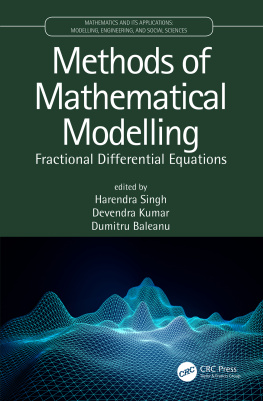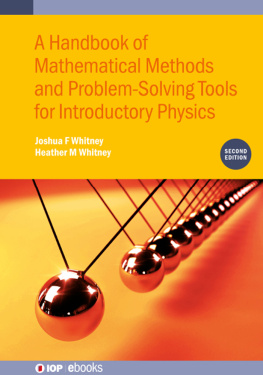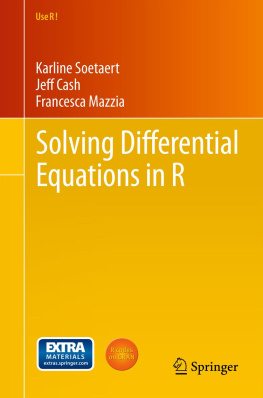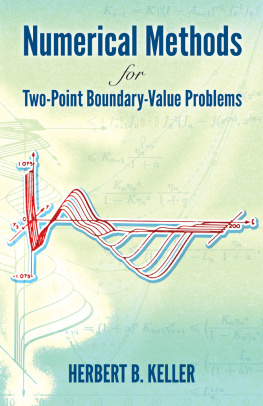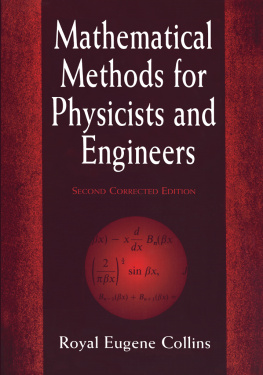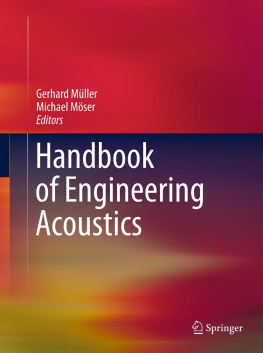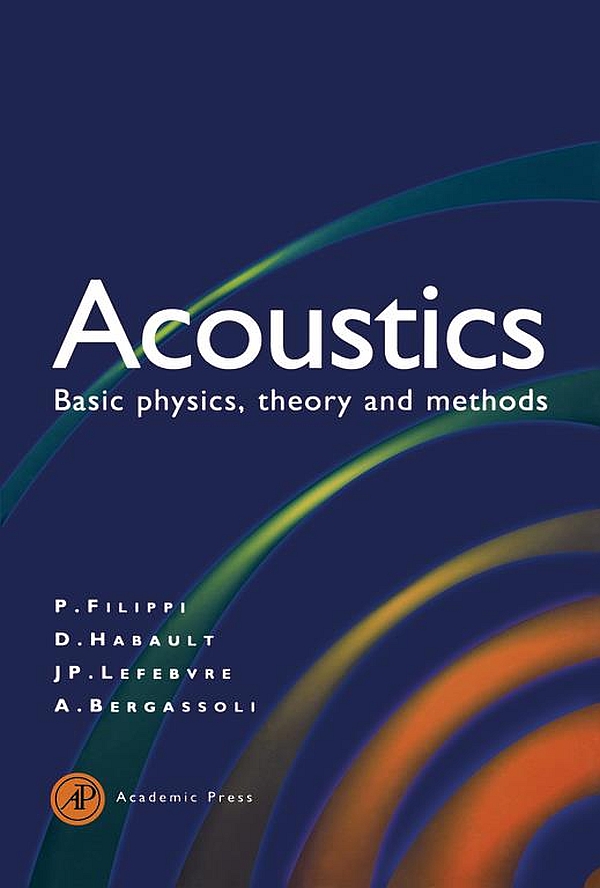Acoustics
Basic Physics, Theory and Methods
First Edition
Paul Filippi
Dominique Habault
Jean-Pierre Lefebvre
Aim Bergassoli
Laboratoire de Mcanique et d'Acoustique, 13402 Marseille cedex 20, France
ACADEMIC PRESS
San Diego London Boston
New York Sydney Tokyo Toronto
Copyright
This book is printed on acid-free paper
Copyright 1999 by ACADEMIC PRESS
All Rights Reserved
No part of this publication may be reproduced or transmitted in any form or by any means electronic or mechanical, including photocopy, recording, or any information storage and retrieval system, without permission in writing from the publisher.
Academic Press
2428 Oval Road, London NW1 7DX, UK
http://www.hbuk.co.uk/ap/
Academic Press
a division of Harcourt Brace & Company
525 B Street, Suite 1900, San Diego, California 92101-4495, USA
http://www.apnet.com
ISBN 0-12-256190-2
A catalogue record for this book is available from the British Library
Typeset by Mathematical Composition Setters Ltd, Salisbury, Wiltshire
Printed in Great Britain by MPG Books Ltd, Bodmin, Cornwall
99 00 01 02 03 04 MP 9 8 7 6 5 4 3 2 1
Foreword
P.E. Doak
At the invitation of the authors, it is my privilege to contribute a Foreword to this book. It is an English-language version of the French-language Acoustique Gnrale , published in 1994 (which I reviewed in JSV 186(5)), translated into English and revised by the authors to make its contents more accessible to English speakers.
Its contents are what is important. No other English-language book on acoustics contains as much concise information, both physically and mathematically rigorous, on the basic physical and theoretical concepts of acoustics and the methods of obtaining solutions applicable to practical problems of the mathematical problems of acoustics.
Although acoustics is presented in the book as a collection of mathematical problems and how to solve them, the physical bases of these problems are initially spelled out in generality in the first chapter, in the context of continuum mechanics (which is not done in any other books on acoustics). In the subsequent seven chapters, both mathematically rigorous and approximate methods of solving the acoustical equations thus described are presented, including both analytical and numerical methods. The presentation throughout is very concise, and so the book is like a diamond mine for those willing to dig deep enough to find diamonds which encapsulate the problems they wish to solve. Since the authors, however, have all been brought up in the French tradition of rational mechanics, rather than the empirical mechanics tradition favoured among most English speakers, I have to conclude by saying that English-speakers must be prepared to dig deep into the book if they want to find their diamonds. If they do so, I am sure that they will be duly rewarded.
Preface
Dominique Habault; Paul Filippi; Jean-Pierre Lefebvre; Aim Bergassoli, Marseille, May 1998
These lecture notes were first written in French, while the authors were teaching Acoustics at the University of Aix-Marseille, France. They correspond to a 6-month course given to postgraduate students before they begin a Ph.D. thesis.
The reason for writing this book was, at the time we began, the lack of textbooks. Most of the books were either too specialized, and thus almost incomprehensible for students, or too exhaustive. We needed a basic course which could be presented within a rather short period of time to students who had a fair background in Mathematics and Mechanics but often no knowledge of Acoustics.
The purpose of this book is to present the main basis of modelling in Acoustics. The expression modelling used here includes the procedures used to describe a physical phenomenon by a system of equations and then to solve this system by analytical and/or numerical methods. The unknown function of the equations is generally the sound pressure itself or some related function. First (and most) of all we wish to stress that when modelling a phenomenon it is necessary to have a good knowledge of the approximations introduced at each step, the kind of neglected phenomena and the conditions of validity of the solution methods. In wave propagation, for example, the unit length that is well adapted to the description of the phenomenon is the wavelength. Then there are low frequency and high frequency methods, and all dimensions must be compared with the wavelength. It is always essential to choose reasonable approximations and the methods adapted to the problem. It is obviously a nonsense to develop or run a big routine in order to compute results which can be obtained simply through analytical methods. The book tries to give a clear overview on these aspects.
Throughout the book we insist also on the properties of the solutions mainly existence and uniqueness. One and only one solution corresponds to a stable physical phenomenon. It is therefore both natural and essential that the corresponding system of equations has one and only one solution. It must not be believed that because almost all problems must be solved with a computer, there is no need to examine the properties of the solutions. We attempt to show that mathematical theorems cannot be ignored when modelling physical phenomena and solving equations.
Another purpose of this book is to provide the reader with basic and main concepts in order that he could read more specialized publications.
Apart from corrections or improvements, the content has only been slightly modified from the French version. , originally written by C. Lesueur and J.L. Guyader, is replaced by a chapter on the same subject written by P. Filippi.
The book is split into nine chapters. The aim of is to establish wave equations in fluids and solids by linearizing the equations of conservation of mass, momentum and energy. The equations are obtained for homogeneous and heterogeneous media, boundary conditions, moving sources, etc.
is devoted to Acoustics in bounded domains. Methods to solve the Helmholtz equation are presented: method of separation of variables, image method and Greens representations. They are applied to several examples. The respective roles of eigenmodes and resonance modes are also shown and detailed in an example. The results are applied to the description of the establishment and extinction of sound.
is dedicated to boundary value problems solved by methods based on Greens kernels and integral representations. The radiation of simple sources in free space is expressed by using Greens kernels. Then Greens representations of the sound field, layer potentials and boundary integral equations are examined in detail. As an example of application, the Neumann problem for a circular boundary is considered.
is devoted to outdoor Acoustics. Phenomena of outdoor sound propagation are divided into three parts: propagation above ground, diffraction by an obstacle and propagation in an heterogeneous medium. For each of them a general survey of solution techniques is presented.
is a general presentation of (partly) analytical methods used in Acoustics. They are all based on analytical representations or approximations. Most of them are related to asymptotic expansions. They are all characterized by particular conditions of validity which must not be forgotten when using them. These conditions are described for each method.
. It is dedicated to boundary integral equations: solution techniques, eigenvalue problems and singularities.


